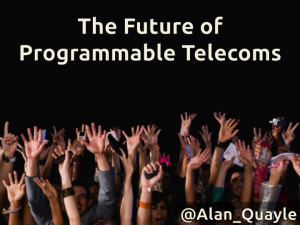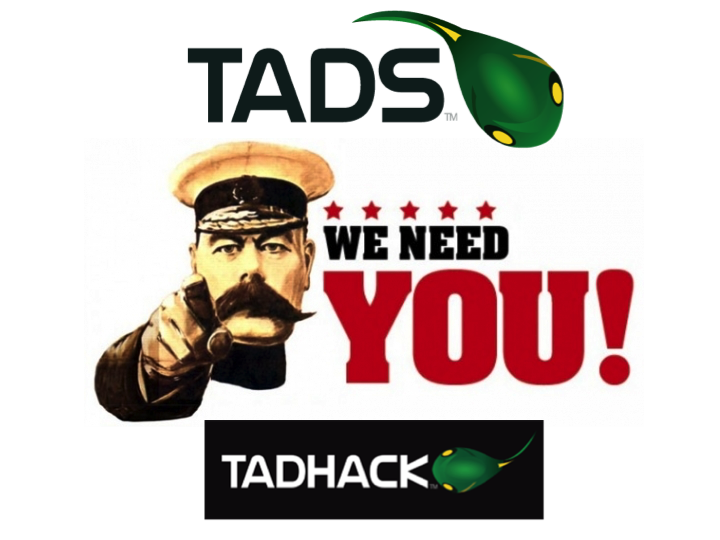 At Restconn 2017 in Prague 23-25 May I gave a presentation on the Future of Programmable Telecoms. As the first presentation of Day 2 at 8AM, I started gently as some listeners soothed their hangovers 😉 I thought it best to show most experts are wrong with most of their predictions, including me. With examples from Michael Fish and the hurricane of 1987, Decca Records missing out on the Beatles, Robert Metcalfe predicting the collapse of the internet, nuclear powered vacuum cleaners, lots of people flying in jumpsuits, Space:1999 Moonbase Alpha, and The Donald.
At Restconn 2017 in Prague 23-25 May I gave a presentation on the Future of Programmable Telecoms. As the first presentation of Day 2 at 8AM, I started gently as some listeners soothed their hangovers 😉 I thought it best to show most experts are wrong with most of their predictions, including me. With examples from Michael Fish and the hurricane of 1987, Decca Records missing out on the Beatles, Robert Metcalfe predicting the collapse of the internet, nuclear powered vacuum cleaners, lots of people flying in jumpsuits, Space:1999 Moonbase Alpha, and The Donald.
I gave a few pointers on how to spot dodgy predictions, and explained the limitations of mine. Then focused on showing programmable telecoms is here with lots and lots of successful examples. Its just not that evenly distributed – quoting William Gibson. Though given I’ve been working on telecom APIs since the nineties its adoption curve is more like the telephone than the internet.
Programmable Telecoms covers: calling, sending text messages (SMS and IM), sending audio and video messages, video calling/streaming, faxing (yep, fax still exists), secure communications (encrypted), decentralized communications (decentralized web), mobile payments, and much much more is possible through easy to use APIs, SDKs, and GUIs. It can be:
- cloud, on premise, or hybrid, or virtualized, or just running on your laptop;
- open or closed source, or a mixture;
- purely IP based, or purely PSTN based, or a mixture;
- private, public, regional, country-wide or global.
It covers acronyms such as A2P (Application to Person), cPaaS (communications Platform as a Service), UCaaS (Unified Communications as a Service – which is a subset of cPaaS), WebRTC, SIP, SS7, RCS, PSTN, IP-RTC (Real Time Communications), etc.
The fundamental property is its telecoms-based and its programmable. Which means Restcomm is at the heart of Programmable Telecoms.
I focused on an interesting area of A2P (Application to Person), that is messaging between businesses (and their applications) and people, not person to person (p2p) messaging. A theme of many presentations at Restconn. Its a large and growing market that is becoming much more complex. It must not be viewed as only A2P SMS. IP based messaging is becoming increasingly important across email, notifications, messaging platforms like FB Messenger, LINE, Slack, voice and video messaging, fax, RCS (what Android has planned with Jibe), and what Apple is likely to do with iMessage. The only way to compete in this market is through programmable telecoms to solve omni-channel complexity.
Programmable Telecoms is the most important change in our industry, and the most ignored change as the incumbents (GSMA, TMF, big vendors) dislike change they can not control. Instead they focus on topics like NFV, transformation, 5G, and ‘OTTs taking advantage’ to keep the large POs (Purchase Orders) flowing. Programmable Telecoms is democratizing telecoms, so many more people can create value and solve problems using telecoms. That is why most of the value created in Programmable Telecoms is outside the traditional Telco ecosystem. See this weblog explaining the difference between Telco and Telecom. But that is changing, as Vonage bought Nexmo, BICS bought TeleSign, and xVNOs are taking control over their services.
Ecosystems like Restconn need to work together to promote programmable telecoms. We need a logo for programmable telecoms (like 5G) to help us all promote the category. If you have an idea for a logo, let me know. We need to work together to accelerate awareness of programmable telecoms, it should be a common theme across Restconn ecosystem members’ marketing plans.
I wrapped up with a summary of TADHack and TADSummit that promote programmable telecoms. TADHack is focused on developers, programmable telecoms technology, and creativity. While TADSummit is focused on the business of programmable telecoms. The benefits of getting involved in TADHack include:
- You’ll be part of the world’s largest global hackathon over one weekend. Its the largest telecom-focused hackathon since we started in 2014.
- Hiring: meet many local, world-class, motivated people.
- Brand awareness & thought leadership: through supporting or running locations.
- Business development: discover joint business opportunities.
- Learning: new technologies, problems faced in other industries / communities.
- Make friends and have fun: TADHack is an intense experience!
- TADHack provides continuous collateral (all pitches are recorded) and promotion for those who take part throughout the year.
TADSummit is The Programmable Telecoms event. Telecoms is now programmable, almost every aspect of Telecoms can be an app, like the Web. It covers: contextual communications, conversational CRM and BOTs, M2M and IoT, telecom APIs and WebRTC, internal innovation in non-telecom industries, decentralized web, application-to-person comms, network app stores, enterprise telecom apps, open source telecom, open networks, etc. TADSummit is open, no BS, practice-based, business/strategy, world-first demos, thought-leadership, and companies involved keep being bought (Nexmo, Tropo, Solaiemes)!
I finished with a final thought. Back in 1999 the world’s first MVNO, Virgin Mobile, launched. We had no moonbase nor people flying about in jumpsuits like the predictions of 1999. However, today virtualization has gone further. You no longer need to own a network OR resell network services. Its all just IP and you/customers define the services! Its an exciting time for xVNOs (x can be mobile, fixed or converged).

Pingback: Announcing TADSummit 2017 - Blog @ Telecom Application Developer Summit (TADS)